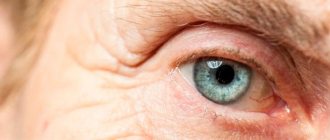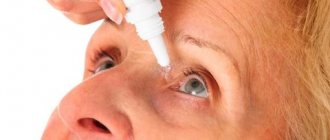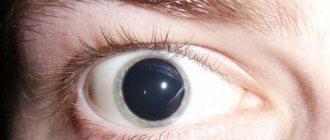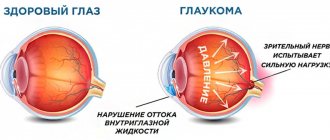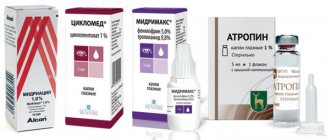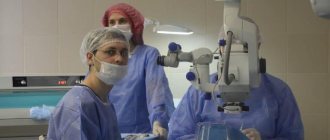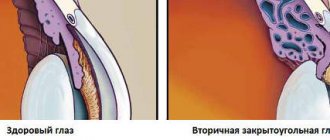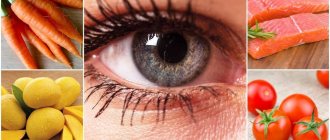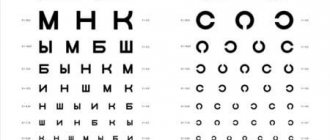Types of drops that reduce intraocular pressure
Drops for the treatment of glaucoma are produced in large quantities. Each of them contains certain drugs, which can be divided into several groups:
- Based on the active component, beta blockers, prostaglandins, cholinomimetics, etc. are distinguished.
- According to the mechanism for eliminating intraocular hypertension, there are drugs that reduce the synthesis of aqueous humor, drugs that improve its outflow, and combined drugs.
Prostaglandin analogues
Prostaglandins are the safest and most effective agents for the treatment of glaucoma. 2 hours after instillation of this group of medications, the pressure inside the eye begins to decrease, and the maximum effect is observed after 12 hours.
This group of drugs includes Travatan, Tafluprost, Xalatan. All of them appeared relatively recently, but due to their high efficiency and duration of action (up to 24 hours), these drugs have become very popular in the treatment of patients with glaucoma.
Prostaglandins help restore the outflow of aqueous humor through additional pathways. However, these drugs also have some side effects. These include:
- Temporary redness of the eyes as a result of an increase in the diameter of the superficial arteries;
- Changes in the color of the iris due to pigment accumulation;
- Stimulates the growth of eyelash hairs; they also darken and become thicker (this effect is sometimes beneficial and can be used for cosmetic purposes).
Beta blockers
The mechanism of action of beta blockers is to reduce the synthesis of aqueous humor. They begin to act half an hour after instillation, and the effect reaches its maximum after about 2 hours. The frequency of use is higher than that of prostaglandins (usually 2 times a day), which is less convenient for the patient. Often, beta blockers for the treatment of glaucoma are combined with prostaglandins to increase the effectiveness of therapy.
There are a large number of eye drops belonging to this group (Timolol, Okumol, Arutimol, Okumed, Okupress, etc.). The active substance used in the drops is usually the same, so they are all interchangeable.
Beta blockers can have negative effects on body systems, such as causing bradycardia or bronchospasm. Therefore, this group of drugs is not used in patients with concomitant pulmonary emphysema, heart or vascular diseases, or bronchial asthma.
Highly selective beta blockers, which have significantly fewer side effects, include Betoptik.
Carbonic anhydrase inhibitors
Carbonic anhydrase inhibitors include Azopt and Trusopt. The mechanism of their action is associated with inhibition of intraocular moisture production. These medications are quite effective and, at the same time, safe, since there are practically no side effects when using them.
The only thing is that patients with certain diseases of the excretory system need to be careful. Typically, carbonic anhydrase inhibitors are prescribed for double use; they are often combined with other groups of drugs (beta blockers, prostaglandins)
Diacarb tablets have a similar effect to Azopt, so it can also be prescribed to patients with glaucoma, especially during an acute attack of intraocular hypertension.
Cholinomimetics
The drugs Pilocarpine and Carbocholine are used to normalize the outflow of aqueous humor through the drainage system. They lead to narrowing of the pupillary opening and contraction of other muscle fibers, as a result of which the angle of the anterior chamber is freed from obstructions. Most often, cholinomimetics are prescribed to patients with angle-closure (narrow-angle) glaucoma to increase the size of the angle. The frequency of use is 1-2 times a day. These drugs are combined with drugs from other pharmacological groups (beta blockers, prostaglandins, carbonic anhydrase inhibitors).
Due to the pronounced narrowing of the pupillary opening, when using these medications, the field of vision may narrow and pain may appear in the temporal, frontal and superciliary areas.
Combination drugs
For the convenience of patients, several eye drops have been developed, consisting of active substances from different groups. This allows you to reduce the number of vials with medications, and sometimes the frequency of instillation.
Most often, ophthalmologists prescribe the following combination drops:
- Xalacom, which includes Timolol and Xalatan;
- Cosopt, consisting of Timolol Trusopt;
- Fotil, which contains Pilocarpine and Timolol.
List of the most popular drops
The choice of eye drops for glaucoma is made only by an ophthalmologist after a thorough diagnosis and identification of the cause of the disease. But a patient who has been diagnosed with glaucoma needs to know which medications can be used against it and which cannot, and navigate through numerous medications.
The best eye drops for glaucoma that reduce the production of intraocular moisture are as follows:
- Timolol. Good drops against glaucoma. The product blocks special receptors in the ciliary body of the eye, where moisture is produced. As a result, IOP is quickly and effectively reduced. The drug is inexpensive, its cost is approximately 20-40 rubles. The disadvantages include the inability to use for pathologies of the lungs, heart, low blood pressure, arrhythmia, and asthma. An analogue is Metipranolol, which does not contain preservatives.
- Azopt, Brinzopt. These eye medications contain brinzolamide as the basis. This substance slows down the enzyme caronehydrase, which helps increase the amount of moisture inside the eye.
- Betaxolol. One of the most effective drops. The active substance can be contained in quantities of 2, 5 mg and 5 mg. Disadvantages include discomfort after instillation in the form of burning and lacrimation.
- Xalatan (latanoprost). The active substance of the drug is latoprost. A milliliter of drops contains 500 mcg. A fast-acting and at the same time safe drug, without side effects. Its action is aimed at enhancing the outflow of intraocular moisture.
- Pilocarpine. The active substance of the drug is pilocarpine hydrochloride. A drug that has a miotic effect (constricts the pupil), due to which the anterior chamber of the eye is released, and the intraocular fluid can circulate normally. The product should not be used for inflammation of the eye structures or in the presence of diseases when pupil constriction is undesirable.
- Travatan. The active substance of these drops is travoprost. Strengthens the outflow of fluid accumulating between the cornea and lens.
- Aceclidine. An effective remedy for reducing intraocular pressure. The disadvantages include many side effects (inflammation of the iris, redness of the conjunctiva). Only a doctor prescribes it.
- Mexidol. The best remedy for glaucoma for old people. Indicated in the treatment of senile glaucoma associated with degenerative changes in the ocular structures. The disadvantages include the low effectiveness of the drug. The pressure in the eye does not decrease much, but after its use the angle of peripheral vision increases significantly.
- Irifrin. The active ingredient phenylephrine reduces eye pressure without affecting the accommodative apparatus, which is responsible for optimal distance and near vision. The disadvantage is a large number of contraindications. These are diabetes, hypertension, heart pathologies.
Glaucoma and the main causes of its occurrence
Basically, a disease such as glaucoma manifests itself in older people, although medicine is also familiar with variants of the disease in people of any age, even children. Glaucoma is accompanied by increased intraocular pressure, which can cause many consequences if left untreated.
An easier option for eye surgery now is laser intervention. This procedure helps to injure the eye itself less and at the same time improve its condition. Such operations help improve the outflow of fluid and stabilize the patient’s condition.
There are several main causes of the disease. The first option is the occurrence of increased pressure inside the eye. In this condition, the eye is subject to severe stress for a long period of time. In addition, it impairs blood flow and the normal condition of the eye. Visually, this symptom becomes noticeable due to constantly red eyes and inflamed eyelids. The second cause of the disease is fluid accumulation. With poor blood circulation, lymph can linger and accumulate in the eye area. For the patient, it will feel like a foreign body getting into the eyelid, for example, like sand in the eyes or something like that. Glaucoma may be accompanied by the occurrence of other, mainly infectious diseases. The cause of infections is stagnation of fluid in the eyeball area.
The cause may also be an incorrect lifestyle or prolonged work in dark rooms, which can provoke a structural deviation in the structure of the retina. But congenital defects of the retina are not uncommon.
Destruction in the functioning (dystrophy) of the optic nerve. If cataracts occur for this reason, treatment should be carried out immediately, since there is no way to predict the further functioning of the nerve. Delays in treatment can cause vision loss. And these are only the main causes of the disease, and there are about five dozen other causes that can cause glaucoma.
About risk factors
In addition to the direct causes of cataracts, numerous risk factors should be taken into account. We have already talked about diabetes mellitus above. If the patient suffers from a hereditary pathology such as Marfan syndrome, or hepatocerebral dystrophy (Wilson-Konovalov disease) with copper deposition in the body, then this diagnosis is a significant threat to vision, and cataracts in such patients can occur at a young age. Down syndrome (trisomy 21 pairs), a decrease in the function of the parathyroid glands, in which calcium accumulates in the body and can be deposited, including in the tissues of the lens, is also a risk factor. A risk factor is high blood pressure.
If we talk about congenital forms, then the presence of toxoplasmosis, cytomegalovirus infection, syphilis or herpetic infection in the expectant mother significantly increases the risk of developing not only cataracts, but also severe pathology of the fetus, sometimes incompatible with life. In adults, one of the simplest, known risk factors that can be easily eliminated is smoking. Men and women who smoke develop cataracts much more often than non-smokers.
Which drugs are considered the most effective and safe?
Which drops to choose for cataracts?
The attending specialist decides which drops to choose for effective treatment of a particular eye disease. What will be most effective for cataracts? Again, it all depends on the degree of neglect of the disease and the nature of its origin.
For example, for the treatment of senile and diabetic cataracts, Catalin drops are considered the most effective, as they can effectively improve the nutrition of eye cells.
Most often, Quinax is prescribed for various types of cataracts. They effectively resolve cloudy protein compounds on the lens.
In third place in terms of effectiveness is Oftan Katahrom, which has a powerful targeted antibacterial effect.
What is effective for glaucoma?
For a disease such as glaucoma, complex treatment is prescribed using several categories of drugs. There is also no identical recipe for the treatment and prevention of various forms of glaucoma.
Only a specialist can select effective drops for glaucoma. For this purpose, a comprehensive examination of the patient is carried out to identify diseases such as asthma, cardiac ischemia, and possible problems with the liver and blood circulation.
The maximum effect of drops is achieved due to the ability of many drugs to improve the outflow of excess intraocular fluid. It is these products that are recognized as the most effective, among them it is worth highlighting Azarga drops, which have a strong effect.
If there are no tangible results from such treatment, then additional drops are prescribed, which not only improve the outflow of fluid, but also have the ability to reduce the production of this moisture.
To avoid unwanted addiction to the drops, it is necessary to periodically change the drug, this will make the treatment process even more effective. Only an ophthalmologist prescribes a replacement. Self-medication in this case is very dangerous.
The most prescribed drops for glaucoma:
- available - Timolol;
- soft - Proxodol;
- popular - Betoftan;
- potent ones - Xalatan, can actively affect the eyes;
- Xalacom has many necessary effects, including disinfecting the eyes, moisturizing, relaxing the eye muscles;
- expensive - Kosopt, this drug is enough for long-term use;
- A high-quality drug, Lanotan, has good effectiveness in the treatment of this disease.
In any case, you should not take anything from the list listed on your own; you need to entrust the prescription of the drug to a specialist in order to avoid irreparable consequences.
Rules for using eye drops
For any disease, the choice of medicinal drops is made only by a doctor after identifying possible contraindications and assessing interactions with other drugs.
When using this treatment method, you should adhere to several basic rules:
- do not instill the medicine while wearing soft contact lenses;
- do not touch the skin of the eyelid with the pipette;
- carry out treatment regularly, without omissions;
- try to maintain equal intervals between drops;
- continue treatment even if results are quickly achieved;
- Do not replace one drug with another without a doctor’s prescription.
Drops have an effect on the iris, glands of the digestive and respiratory systems and external secretion. During the use of antiglaucoma medications, muscle contraction occurs, which stimulates the functioning of the intraocular nerves.
Drops should not get inside, otherwise stomach problems and dizziness may occur.
How to instill drops correctly:
- The drops should enter the conjunctival sac. After administration, you should press the area near the inner corner of the eyes with your finger. You need to instill no more than two drops.
- If several drops are used simultaneously, the optimal time interval between instillations is up to ten minutes.
- After instillation, the eye is closed tightly so that the medicinal components are better absorbed into the bloodstream. Such measures will also help avoid adverse reactions.
- Thirty to forty minutes after instillation, the drug begins to act. At the same time, eye pressure is reduced by twenty-five percent. And after two hours the maximum effect occurs, which lasts up to eight hours.
The effectiveness of drops as medicine
Despite the wide variety of eye drops used in the conservative treatment of cataracts and glaucoma, the most effective are drugs that affect the cause of the disease. For cataracts, these are substances that normalize the transparency of the lens.
They give a good effect in the initial stages. Unfortunately, it is impossible to completely rid a person of cataracts using drops. But they work well as a means of prevention and during the rehabilitation period after surgery.
Glaucoma is a more serious disease for which there is no cure. But long-term and regular courses of eye drops can avoid deterioration and preserve vision.
Glaucoma and cataracts - treatment with folk remedies
In addition to medications and surgery, it is worth trying traditional methods of treating glaucoma. There are many recipes that will help you feel better and even get rid of the problem completely. Compresses are mainly used for this.
Lily of the valley in the fight for vision It is necessary to measure half a glass of nettle into a bowl, add one teaspoon of lily of the valley flowers and fill it all with a glass of cool water. After 9 hours, add half a teaspoon of baking soda to the infusion and stir. Make a compress from the resulting mass and apply it for 20 minutes daily.
Aloe is great for rinsing the eyes. After washing the aloe leaf, chop it finely and then add a glass of hot water. The liquid is infused for three hours, after which it is filtered and the eye is washed with it. It is recommended to repeat the procedure 3 times during the day.
Glaucoma can also be treated with the help of a golden mustache. To do this, you need to take a leaf of golden mustache (about 20 cm long), and, having cut it, pour a liter of boiling water. After letting the decoction brew for a day, drink it half an hour before meals 4 times a day.
The duration of such treatment is 21 days. After a break of one month, treatment is resumed. In addition, the golden mustache can also be instilled into the eyes. For this, fresh plant juice is used: instillation lasts 10 days.
Baked sea onions, rowan berries, viburnum, red currants, and strawberries are also used to treat cataracts. It is also possible to treat glaucoma with honey. To create the product, you need to mix honey with aloe juice (one teaspoon of each), and add 1 tablespoon of water. The mixture should be instilled into the eye before going to bed every evening. Treatment continues until improvement occurs.
Eye lotions will also help with glaucoma. You need to prepare a linen bag (about 5x5 cm), fill it with dill seeds in the evening and soak it in boiling water. After the bag of dill has cooled, place it on your eyes for 20 minutes before going to bed. This procedure is repeated daily before bed until the first signs of improvement.
Folk remedies from honey
Honey helps fight many diseases and is also suitable for treating cataracts. It is better to take May honey or acacia honey. It is dissolved in a steam bath and dropped into the eyes 2 times a day, one drop. This method allows you to partially remove the symptoms of the disease and eliminate the risk of developing glaucoma.
Cataracts should be treated with this method within 21 days. After this, you need to take a 2-week break and repeat the course several times over 3-4 months. It should be remembered that the method cannot be used in hot weather, so it is better to postpone treatment to autumn or spring. If you carry out the procedures regularly, you can do without surgery.
Medicinal plants
Cataract symptoms will become less severe if you use various herbs to treat the disease. Treatment of cataracts using traditional methods may cause mistrust in some people. These methods are accessible, effective and time-tested.
Thanks to the experience passed down through generations, many people today can experience relief and overcome the disease. The main thing is to do all this under the supervision of an experienced ophthalmologist.
Cleansing the eyes with infusions and decoctions
In order to prevent the development of glaucoma, you can wash your eyes daily with medicinal infusions and decoctions. Some medicinal herbs can reduce intraocular pressure levels, serving as an excellent alternative to medications. However, any herbal preparations should be used only after consultation with a specialist.
The most useful herbs:
- eyebright – has a pronounced ability to reduce intraocular pressure;
- aloe – used for rinsing for two weeks, after a two-week break the course can be repeated;
- golden mustache - a decoction of the plant is dripped into the eyes to reduce intraocular pressure; it can be taken orally as an infusion.
You need to rinse your eyes using a pipette. Gently pull the lower eyelid down using a cotton swab. Without touching the eyelashes with a pipette, you need to drop 2-3 drops of infusion or decoction into the conjunctival cavity. After this, blink a little and remove any remaining medication with a clean cotton swab.
For rinsing, it is better to use freshly prepared decoctions and infusions. Medicines can also be stored in the refrigerator, but not more than a few days. Before rinsing your eyes, you must wait for the liquid to reach room temperature.
Massage
Light self-massage of the eyes and massage of the collar area are also useful for the prevention of many ophthalmological diseases. During a break from work, you should close your eyes and gently massage them with one finger. Direction of movements: lower eyelid - from the outer corner of the eyes to the inner, upper - vice versa. Light rubbing and kneading of the circular muscles of the eyes and eyelids relieve fatigue quite well.
As you know, at the level of the cervical and thoracic spine there are nerve endings associated with the visual organ. They are to some extent responsible for the condition of the eyes and visual acuity. Therefore, massage of this area allows you to improve the functioning of the visual analyzer, normalize its metabolism and blood circulation.
You can do a neck massage yourself by thoroughly massaging all accessible areas. The larger the area captured, the better for the eyes. Also, massage of the cervical-collar area can be done by a qualified specialist. In this case, the procedure should be therapeutic, not relaxing.
initial stage
In the initial stage, the main symptom will be a gradual decrease in visual acuity. Sometimes the initial stage may be asymptomatic. The lens, as the optically transparent medium of the eye, is normally larger in size than the pupil, and the pupil is a simple hole. If clouding of the lens occurs at its edge and does not interfere with the projection of optical images of objects through the lens, then there may be no symptoms. But if the cataract is located in the center of the pupil, then vision will be lost quite quickly. Along the way, the patient will have distorted sizes of objects, or may have so-called monocular polyopia. If you close one healthy eye, then when looking with the affected eye you can see the fragmentation of the contours of the same object and their multiplication. These symptoms last no more than 3 years, and then the cataract transforms into a swollen, immature stage.
Treatment with eye drops
The main goal of treatment is to reduce IOP to an acceptable level, which is achieved in two ways:
- decreased production of intraocular fluid
- improvement of fluid outflow.
Optimism is inspired by the fact that the course of glaucoma can be controlled if it is detected early, and thanks to conservative and/or surgical treatment, most patients with glaucoma do not lose the ability to see.
Treatment tactics for glaucoma depend on its type, cause of development, and severity of the disease. Treatment of any vision-related diseases is a capacious and rather complex process. In most cases, full recovery requires surgery, which can carry many risks.
To maintain the normal condition of the eye, you can use eye drops, which will slightly improve the condition and vision of the patient.
In most cases, eye drops for glaucoma do not provide complete recovery, but bring temporary improvement. Glaucoma drops can give a chance for recovery only at the initial, easiest stage.
For a disease such as glaucoma, complex treatment is prescribed using several categories of drugs. There is also no identical recipe for the treatment and prevention of various forms of glaucoma.
Only a specialist can select effective drops for glaucoma. For this purpose, a comprehensive examination of the patient is carried out to identify diseases such as asthma, cardiac ischemia, and possible problems with the liver and blood circulation.
The maximum effect of drops is achieved due to the ability of many drugs to improve the outflow of excess intraocular fluid. It is these products that are recognized as the most effective, among them it is worth highlighting Azarga drops, which have a strong effect.
To avoid unwanted addiction to the drops, it is necessary to periodically change the drug, this will make the treatment process even more effective. Only an ophthalmologist prescribes a replacement. Self-medication in this case is very dangerous.
The most prescribed drops for glaucoma:
- available - Timolol;
- soft - Proxodol;
- popular - Betoftan;
- potent ones - Xalatan, can actively affect the eyes;
- Xalacom has many necessary effects, including disinfecting the eyes, moisturizing, relaxing the eye muscles;
- expensive - Kosopt, this drug is enough for long-term use;
- A high-quality drug, Lanotan, has good effectiveness in the treatment of this disease.
In any case, you should not take anything from the list listed on your own; you need to entrust the prescription of the drug to a specialist in order to avoid irreparable consequences.
Recommendations for illness
Persons over 40 years of age are at significant risk of encountering a complication of glaucoma, blindness. This is explained by the fact that primary glaucoma most often appears after 40.
A complication of the disease should be considered not only blindness, but also the progression of malignant glaucoma against the background of a persistent increase in the level of intraocular pressure. Fortunately, this form of the disease is practically not common and can only be encountered during certain surgical interventions on the eye.
The best results are achieved by timely prevention of eye diseases and glaucoma in particular. By addressing issues of glaucoma prevention, the patient protects his health and prevents the risks of severe disability.
Classic measures to prevent glaucoma include:
- eye drops;
- lectures for the public covering the emergence of glaucoma and describing the first signs of this disease;
- preventive examination by an ophthalmologist.
It is better to carry out a preventive examination in the ophthalmologist’s office regularly, at least once a year after 40 years. Persons with unfavorable heredity and risk factors can visit an ophthalmologist earlier, after 30 years.
It's better to spend a day visiting a doctor than to lose your visual acuity. And the simplest measures can help preserve vision for a long time: early diagnosis of glaucoma and treatment of the disease at an early stage.
This especially affects the interests of people with farsightedness, after eye surgery, and with hereditary manifestations of glaucoma.
Glaucoma drops
Drugs that reduce the production of intraocular fluid
Beta blockers:
- Timolol (Arutimol, Okumed, Okumol, Okupres-E, etc.).
- Betaxolol (Betoptik, Betoptik S).
Treatment for glaucoma usually begins with these drugs.
But if they turn out to be ineffective, doctors prescribe drugs with a different mechanism of action. They inhibit the action of the enzyme carbonic anhydrase, which is necessary for the production of intraocular fluid:
- Brinzolamide (Azopt).
- Dorzolamide (Trusopt, Dorzopt).
Or combination drugs that contain two active substances (a beta-blocker and a carbonic anhydrase inhibitor) that enhance each other’s effect:
- Azarga (brinzolamide + timolol).
- Cosopt (dorzolamide + timolol).
Drugs that improve the outflow of intraocular fluid
If the above drugs are ineffective, doctors prescribe drugs that improve the outflow of intraocular fluid:
- Latanoprost (Xalatan).
- Travoprost (Travatan).
Double acting drugs
In particularly difficult cases, dual-action drugs are prescribed, which both improve the outflow of intraocular fluid and reduce its production:
- Luxfen (Brimonidine).
- Xalacom (Latanoprost + Timolol).
Moreover, all these remedies are used mainly for open-angle glaucoma , since they do not affect the pupil, and therefore do not affect the angle of the anterior chamber of the eye either.
How to maintain good vision?
It is worth immediately noting that at present there are no methods that would guarantee a person’s preservation of eye health, since age-related and genetic factors play an important role in the development of diseases. However, prevention of glaucoma and cataracts can significantly reduce the likelihood of pathology developing.
There are many useful tips for maintaining healthy vision, but first of all, you should try to avoid eye strain. After all, the organs of vision are extremely sensitive, so at the first signs of fatigue it is necessary to find out its cause and eliminate it.
Prevention of eye cataracts primarily consists of protecting the organs of vision from excessive exposure to ultraviolet radiation. When exposed to bright sunshine, you must wear sunglasses or a hat with a visor. You should protect your eyes from injury, dust, etc.
In addition, cataract prevention includes regular intake of vitamins, especially E and A. When primary manifestations of lens opacification are detected, cataract prevention with eye drops prescribed by an ophthalmologist plays an important role. Their use makes it possible to stop the development of the disease.
Prevention of complications of eye glaucoma primarily involves maintaining normal intraocular pressure, the increase of which is the main cause of the development of pathology.
In addition, prevention of glaucoma includes avoiding any activity that involves staying in a position with your head low for long periods of time. Prevention of cataracts and glaucoma - general recommendations:
- Regular preventive examinations with an ophthalmologist. People over 40 years old, with hypertension and endocrine pathologies, as well as with work related to eye strain, are recommended to visit a specialist at least once a year. Timely detection of the first signs of the disease gives a fairly high chance of successful treatment.
- Moderate physical activity.
Physical exercise and regular walks in the fresh air help reduce intraocular pressure, improve blood supply to the eyes, and slow down age-related changes in the lens. A balanced diet. The diet should contain sufficient amounts of protein, polyunsaturated fatty acids, fiber, vitamins and minerals necessary for the eyes. There are no strict preferences, but it is advisable to switch to a balanced diet with a predominance of vegetables and fruits, fish, cereals and whole grains. You should limit sweets as much as possible (chocolate, candies, jam, baked goods, etc.). - Limiting exposure to harmful radiation. It is necessary to protect your eyes from exposure to UV radiation, microwaves and ultrasonic waves of certain frequencies. You should not neglect protective equipment when working with electric welding and other activities.
- Timely treatment of ophthalmological diseases.
Glaucoma and cataracts may be related. For example, in the absence of surgery, cataracts are often complicated by phacolytic glaucoma, and increased intraocular pressure in glaucoma can trigger the development of cataracts. In addition, inflammatory and other pathological processes in the eyeball can become a trigger for a whole cascade of painful reactions and the development of serious complications, including cataracts and glaucoma. - Compliance with the work and rest regime. It is necessary to avoid stress, psycho-emotional and physical overload.
Vision prevention also includes a number of other recommendations. These include eye gymnastics, taking special vitamin-mineral complexes, massage, etc. It is impossible to overestimate the importance of the eyes in our lives, because it is no secret that people receive about 90% of information about the world around them through vision.
However, over time, significant changes occur in the tissues of the eyes associated with the aging process, as in other tissues of the body. That is why, starting from a certain age, many people begin to worry about the question - how to preserve their vision?
The inevitable aging process leads to the development of various eye diseases, among which two occupy a special place - cataracts and glaucoma. These pathologies are the most common in ophthalmological practice.
According to statistics, cataracts are observed in 95–98% of elderly patients, and the manifestation of glaucoma can very often be found in people already in middle age. The “insidiousness” of these diseases lies in the fact that in the initial stages they are practically asymptomatic, and if left untreated they lead to disability.
Information about pathologies
Diseases differ greatly from each other in their origin and manifestation.
Glaucoma: causes, symptoms
The main cause of pathological changes is a disruption in the process of inflow and outflow of fluid in the eye, which leads to an increase in intraocular pressure. Under the influence of high load and insufficient blood circulation, pathological changes occur in the structure of the eye and optic nerve, which begins to atrophy and die. The transmission of visual signals to the brain is disrupted, and the person experiences loss of peripheral vision.
Other symptoms of this eye disease include:
- the appearance of pain and cramps;
- blurred vision;
- blurred vision of the contours of objects;
- redness;
- problems with vision in the dark.
The course of the pathology is irreversible, so timely diagnosis and treatment is of paramount importance.
Cataract: causes, symptoms
The disease is accompanied by complete or partial disruption of the transparency of the lens of the eye. As the pathology progresses:
- visual acuity decreases;
- a veil and fog appear before the eyes;
- the contours of objects become blurred;
- the brightness and contrast of colors decrease;
- a shining halo is observed around the light source.
In advanced cases of the disease, a change in the color of the pupil occurs. It takes on a whitish tint.
Cataracts are often caused by age-related changes in the body. Pathology usually begins to develop after 40 years.
Also at risk are people suffering from:
- arterial hypertension;
- diabetes mellitus;
- glaucoma;
- myopia.
The pathological process can be provoked by:
- taking hormonal drugs;
- injury;
- previous infection;
- abuse of nicotine or alcohol.
Hereditary predisposition plays an important role in the onset of the disease.
How to diagnose diseases?
Diagnosis is carried out by an ophthalmologist. A slit lamp examination of the eyes can help identify cataracts. Additionally, the doctor prescribes laboratory tests of blood and urine, fluorography, and consultations with other specialists.
To detect glaucoma, intraocular pressure is measured using a non-contact air jet tonometer. They also study:
- changes in the optic nerve;
- fields of view.
When carrying out the diagnostic procedure, special equipment is used.
What vitamins are needed for cataracts and glaucoma
Vitamin deficiency often leads to eye diseases. For example, a lack of magnesium, zinc and selenium can trigger the development of cataracts. Regular intake of nutrients slows down the pathological process and stops the progression of eye diseases.
The following nutrients are necessary for the visual organs:
- Tocopherol (vitamin E). The antioxidant is able to protect the eyes from adverse environmental influences.
- Retinol (vitamin A). The component helps preserve vision and prevents the development of pathologies associated with the eyes.
- Riboflavin (vitamin B2). The substance restores the eyes after fatigue, and also eliminates the harmful effects of ultraviolet radiation, supporting the lens.
- Ascorbic acid (vitamin C). The useful component helps strengthen the retina and blood vessels.
- Zinc. The nutrient improves color perception, which is impaired with cataracts.
- Calcium. The element normalizes the functioning of nerve fibers.
Important! Vitamins produce a general strengthening effect, affecting the lens and cornea. Their regular intake is considered to prevent the appearance of cataracts.
Symptoms of cataracts
The most important symptom of progressive cataracts is a gradual but steady decrease in vision. But there are other signs, depending on the stage of cataract development. Cataracts can be “incipient”, immature, mature, or even overripe. Each of these stages of disease development has its own characteristic clinical picture. Complaints may vary depending on the situation, and therefore the only correct determination of the stage can be made based on histological analysis of the lens tissue.
Treatment of myopia with folk remedies
Medicinal plants in combination with special gymnastics will help restore vision in the early stages of myopia. However, such therapy must be used over a long period of time. Healing lotions based on herbs can relieve tension, improve vision, and relieve unpleasant auxiliary symptoms. Useful decoctions and infusions restore the immune system, body tone, and help restore visual functions.
Tincture of fragrant rue
In order to restore visual acuity in case of myopia, it is recommended to take 50 ml of fragrant rue tincture per day. To make it, the leaves of this medicinal plant are finely chopped and 4 g of the finished raw material is poured with 1 glass of white wine. Cover the solution and wait 10 minutes; it is advisable to shake this product from time to time for better infusion. Strain before use.
Bird cherry for myopia
To get rid of myopia in the early stages, as well as relieve tension and fatigue of the eyelids, it is recommended to make rinses or compresses based on bird cherry flowers. To do this, brew 10 g of raw material in 250 ml of boiling water, leave under the lid for 20 minutes, and then filter thoroughly. Two cotton pads are moistened in the resulting solution and placed on top of closed eyelids for 10-15 minutes. You can also gently wash the area around your eyes using this product.
Infusion of eyebright
There are many different folk remedies from eyebright that improve and restore vision in the early stages of myopia. To do this, 15 g of pre-dried and crushed herbs of this medicinal plant are poured with 1 liter of boiling water, after which this remedy is infused for 1 hour in a thermos or other warm place. The solution is then filtered and used as an eye wash. You can also drop 1 drop of this liquid into each eye daily. It is also recommended to take half a glass of eyebright infusion per day. The dosage for children should be no more than 1 tablespoon up to 3 times a day.
Carrots to improve vision
You can improve your vision by using carrot tops, which are washed and chopped. You can also add chopped parsley (it should be 3 times less than carrots). All ingredients are mixed, after which you need to eat 1 tablespoon of this mixture before each meal. Carrot juice (200 ml) mixed with 1 tablespoon of olive oil also helps. Drink this mixture in the morning before meals for 2 months.
Rosemary tincture
If your vision has deteriorated, an alcohol tincture of fresh rosemary will help. To prepare it, you need to pour 1 glass of raw materials with 1 liter of white wine. Infuse this remedy for 2 days, then carefully filter and consume 1 tablespoon orally before meals.
To treat children, you can make an aqueous infusion of rosemary. To do this, pour 3 tablespoons of raw material into 300 ml of boiling water. The solution should infuse for 20 minutes in a warm place, after which it is carefully filtered. You can use it to make eye baths by placing cotton pads soaked in the infusion on your eyelids. It is recommended to do the procedure for 15 minutes before going to bed.
Blueberries for myopia
Due to their high content of manganese and other beneficial vitamins and minerals, blueberries are often used to restore vision in the early stages of myopia. To do this, grind 200 g of berries to a puree (you can grind them in a blender) and pour in 100 ml of well-heated alcohol. The solution is placed in a glass jar, closed with a lid and left to infuse for 3.5 hours. Before use, shake the liquid, mix and drink 10 drops 3 times a day before meals.
To prepare eye drops, you can mix 1 tablespoon of blueberry juice with 2 tablespoons of cool, boiled water and drop 5-6 drops into each eye every morning.
Baths and compresses
For local treatment and prevention of glaucoma, you can use medicinal compresses. They should be applied to the eyes daily for 5-7 minutes. The compress should be made of clean gauze, soaked in a healing infusion at room temperature.
To prepare an eye compress, mix the following herbs:
- dried nettle – 1/5 cup;
- lily of the valley petals - half a teaspoon;
- dry golden mustache leaves - 1 teaspoon.
Pour the crushed herbs with three tablespoons of water and leave for eight hours. Store in a dark place. Use to prepare compresses.
Hot baths for hands and feet made of golden mustache are good for reducing intraocular pressure. It is advisable to do them at night, before going to bed. To prepare the bath, you need to mix the golden mustache decoction with warm water in a ratio of 1:2.
Steam baths are beneficial for the eyes. To prepare them, mix eyebright, elderberry, chamomile, valerian and verbena. Five tablespoons of the resulting mixture are poured with half a liter of hot, just boiled wine. The person should hold their face over the container of liquid, making sure that the steam gets into their eyes.
Overmature cataract
The last, final stage of cataract development is an overripe state. Here we are talking about the complete disintegration of the lens, it ceases to exist as an anatomical formation and becomes a porridge-like homogeneous mass. Its dense core gradually descends, vision is completely absent, and even the direction of the light flux may be incorrectly assessed by the patient. Typically, patients with the stage of overripe cataracts are currently found in remote villages, or are immobile, and therefore cannot schedule an appointment for surgical treatment in a timely manner. At this stage, urgent surgery is already necessary, but at the stage of initial and immature cataracts, it is quite possible to treat the patient conservatively. What treatment options exist on an outpatient basis, without surgery?
